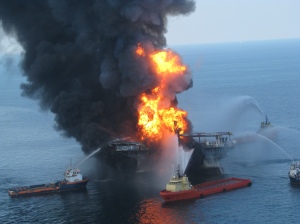 The more things change, etc. Now in the aftermath of the Gusher in the Gulf (more delicately branded as the “Gulf Oil Spill,” as if it were more like a teacup knocked askew than an ocean destroyed) the people who did it, and the people whose job it was to prevent it — the same people who previously told everyone that it could not happen — are shrugging their shoulders, rolling their eyes and saying, “Who knew?”
The more things change, etc. Now in the aftermath of the Gusher in the Gulf (more delicately branded as the “Gulf Oil Spill,” as if it were more like a teacup knocked askew than an ocean destroyed) the people who did it, and the people whose job it was to prevent it — the same people who previously told everyone that it could not happen — are shrugging their shoulders, rolling their eyes and saying, “Who knew?”
In the aftermath, it is becoming clear who knew, as The New York Times recently reported:
- the BP engineers who warned the company, a year ago, that the casing they were using for the well was dangerously thin and could rupture, and that it violated the company’s design standards and safety policies;
- the BP managers who told federal officials in March that they were in danger of losing control of the well in the face of sudden gas eruptions, losses of drilling mud and other mishaps;
- the BP engineers who warned in writing in April that the crew on Deepwater Horizon would not be able to seal the well successfully. Their memo was revised to say, in a second edition, that it would be “possible” to do so;
- the writers of at least three internal memos reporting that the blowout preventer, the last ditch of defense against losing control of the well, was leaking the hydraulic fluid that made it work;
- the operators who complained repeatedly in April that they were encountering blockages in the well casing that should not have been there;
- and the operators who on the day of the blowout, according to survivors, were getting erratic pressure readings that indicated something was seriously wrong deep in the well.
And yet, a senior BP drilling engineer, Mark E. Hafle, told an investigating panel after the disaster that “nobody believed there was going to be a safety issue.”
In a recent edition of PBS’s Frontline examining airline safety, titled “Flying Cheap,” correspondent Miles O’Brien (who is an experienced pilot) pointed out that airline crashes rarely occur without the prior appearance of multiple warning signs giving companies and regulators the opportunity to avert the disaster. One example cited in the program was ValuJet Flight 592, which crashed in the Florida Everglades in May of 1996, killing all 110 people aboard. Mary Schiavo, at the time Inspector General for the Department of Transportation, remembered that red flags has started going up a year earlier, after a non-fatal accident involving ValuJet.
What inspectors found appalled Schiavo. “We found things like duct tape on the planes, cracked windshields and windows, violations on minimum equipment lists — things that you must carry to have a safe flight. We found all these violations.” Before the fatal crash. Neither the company nor the regulators did anything, and after the crash of 592 — immediately after, as Schiavo ruefully recalled for Frontline — “The secretary of transportation flew down to Miami and stood in the Everglades — literally on the watery grave of 110 people — and said, ‘ValuJet is a safe airline.’ He had no way of knowing that. And he had a lot of clues that it wasn’t.”
Of course it sounds familiar. Whether it’s Katrina, Flight 592, the Exxon Valdez or Deepwater Horizon, the politico-industrial complex claims to be operating with perfect safety, then claims total surprise when something terrible happens, then swears that no one did anything wrong, and finally, when the scope of the catastrophe is no longer avoidable, promises to change everything.
Then it’s back to business as usual. That is, of course, until close of business — due to circumstances that were, as will later become clear, entirely within our control..